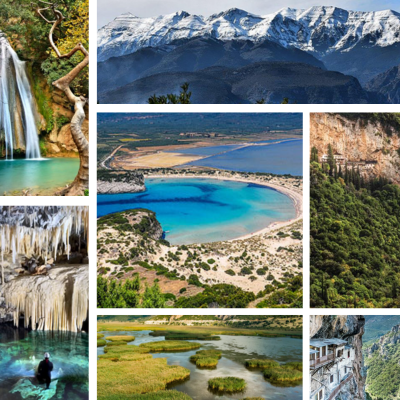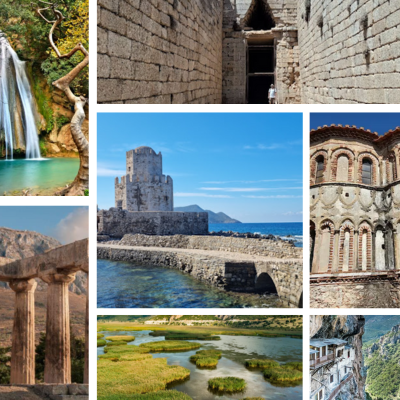The Beauty and Significance of Peloponnese
The Peloponnese, a captivating peninsula situated at the southern tip of mainland Greece, is renowned for its rich history and breathtaking natural beauty.
Spanning a vast area of 21,549.6 square kilometers, this region has long been hailed as the cradle of Greek civilization, boasting a legacy that intertwines with countless mesmerizing myths and legends. From the ancient ruins of Olympia to the majestic peaks of Mount Taygetos, the Peloponnese beckons travelers with its diverse landscapes, vibrant culture, and unparalleled charm.
Whether you’re exploring the ancient ruins of Mycenae or basking in the golden beaches of Costa Navarino, every corner of this enchanting region offers a glimpse into the extraordinary tapestry of Greek history and heritage.
Landmarks of Peloponnese
Mycenae: Echoes of a Legendary Past
Mycenae, the legendary kingdom of the mythical Agamemnon, stands as a testament to the pinnacle of Mycenaean civilization. Its age-old ruins include the imposing Lion’s Gate and the Royal Tombs, offering an insightful glimpse into one of Greece’s most celebrated archaeological sites.
Methoni Castle
Perched on the very edge of the Peloponnesian peninsula, Methoni Castle is a majestic fortress that commands awe-inspiring views of the Ionian Sea. Its robust walls and battlements are silent witnesses to centuries of history, bracing different rulers and invasions.

Ancient Corinth: A Crossroads of Civilizations
Ancient Corinth was a significant city-state in classical Greece, renowned for its commercial and cultural activity. Visitors can explore the Temple of Apollo, the ancient market, and the Acrocorinth, a fortified hilltop offering panoramic vistas.
Mystras: The Byzantine Ghost City
Mystras, once the capital of the Byzantine Despotate of the Morea, is a hauntingly beautiful archaeological site. The city’s ghostly ruins, including fortified walls, palaces, and monasteries, narrate the tale of Byzantine glory and decline.
Ancient Epidaurus
Ancient Epidaurus is home to the best-preserved ancient Greek theatre, famous for its perfect acoustics. The archaeological site also hosts the Sanctuary of Asklepios, a testament to the healing arts in the ancient world.
Monemvasia: The Medieval Fortress Town Suspended in Time
Monemvasia, often referred to as the ‘Gibraltar of the East,’ is a medieval fortress town dramatically situated on a rock off the Peloponnesian coast. This car-free citadel boasts well-preserved Byzantine and Venetian architecture, inviting visitors to step back in time.
Nafplio: The Seaside Gem
Nafplio, the first capital of modern Greece, is a seaside town that’s steeped in history. Its picturesque old town, with its narrow alleyways lined with neoclassical mansions and Venetian houses, is a joy to explore on foot. The Palamidi Fortress, perched atop a hill, offers panoramic views over the Argolic Gulf, while the Bourtzi Castle, a small island fortress, makes for a stunning sight especially at sunset. Nafplio’s diverse cultural influences, vibrant nightlife, and beautiful beaches make it a must-visit destination in the Peloponnese.
Ancient Olympia: The Birthplace of the Olympic Games
Ancient Olympia holds a special place in the annals of history as the birthplace of the Olympic Games. This magnificent archaeological site, nestled in a serene valley in the western Peloponnese, invites visitors to step into a world where athletes competed for glory in the name of Zeus. Key highlights include the Temple of Zeus, one of the largest temples in Greece, and the Stadium, which could accommodate 20,000 spectators. The site also hosts the Archaeological Museum of Olympia, where visitors can admire a wealth of artefacts discovered in the local area, including the renowned statue of Hermes of Praxiteles.
Pylos Castle (Niokastro): A Fortress by the Sea
Pylos, a charming seaside town in the southwestern part of the Peloponnese peninsula, is dominated by the imposing Niokastro, or Pylos Castle. Constructed in 1573 by the Ottomans, this well-preserved fortress offers an insight into the region’s tumultuous past marked by battles and conquests. The castle’s bastions offer splendid views over the town of Pylos and the sparkling Ionian Sea. Inside the fortress, visitors will find the Archaeological Museum of Pylos, home to an array of artefacts spanning various periods from the Bronze Age to the Byzantine era.

The Natural Landscape of Peloponnese
The natural landscapes of Peloponnese hold a distinct allure, showcasing the region’s rich biodiversity and varied topography. The region is a realm of undeniable beauty, encompassing high mountain ranges, verdant forests, tranquil lakes, and pristine beaches. The picturesque landscapes offer a serene retreat for nature lovers and adventurers alike, alongside providing a plethora of outdoor activities such as hiking, wildlife observation, and swimming.
Mani Peninsula
The Mani Peninsula encapsulates the wild beauty of the Peloponnese, with its rugged mountains and dramatic coastline. This region is adorned with traditional stone houses, Byzantine churches, and the historical tower houses, which stand in harmony with the natural surroundings.
Neda Waterfalls
The Neda Waterfalls, a hidden gem in the region, offers a unique spectacle with its turquoise waters cascading down into a verdant valley. The journey to the falls is an adventure itself, meandering through a canyon and an enchanting forest.

Lake Stymphalia
Lake Stymphalia, located in the northeastern Peloponnese, is a natural refuge teeming with diverse flora and fauna. The lake, closely tied to Heracles’ sixth labour in Greek mythology, is also an Important Bird Area, attracting birdwatchers and history enthusiasts alike.
Voidokilia Beach
Voidokilia Beach, often touted as one of the most beautiful beaches in Greece, is a natural paradise with its crystal-clear waters, golden sands, and the backdrop of a lagoon and a medieval castle. The beach, shaped like the Greek letter ‘Omega’, is a perfect spot for relaxation and marine activities.
Mount Taygetos
Mount Taygetos, the highest mountain range in the Peloponnese, offers breath-taking panoramic views from its peak. Its varied ecosystem, featuring rare plant species and wildlife, coupled with ancient paths and monasteries, make it a hiker’s paradise.
Lousios Gorge
The Lousios Gorge, located in the western part of the Peloponnese, is a natural wonder that impresses with its steep cliffs, verdant vegetation, and the Lousios River flowing through it. The gorge is also home to historical monasteries perched precariously on its cliffs and has numerous paths, making it an ideal destination for hiking and exploration.
Mount Parnon
Mount Parnon, a mountain range that stretches across the eastern Peloponnese, is a haven for nature enthusiasts. It is known for its rich biodiversity, including many endemic plant species, and offers numerous trekking paths through its dense forests, rocky peaks, and traditional villages.
Diros Caves: A Subterranean Wonder
Nestled in the Mani region of the Peloponnese, the Diros Caves present an otherworldly spectacle. Visitors have the opportunity to explore this labyrinthine network of subterranean passages by boat, marveling at the stunning stalactites and stalagmites illuminated in the dim light. The Diros Caves, believed to have formed millions of years ago, provide a unique and thrilling adventure into the belly of the Earth, making it a location not to be missed when visiting the Peloponnese.
Conclusion: Peloponnese – A Must-Visit Destination
With its rich history, diverse landscape, and warm Mediterranean climate, Peloponnese is a must-visit destination for any traveler. Whether you’re a history buff seeking to explore the remnants of ancient civilizations, a nature lover looking to soak in the region’s natural beauty, or a foodie eager to savor the flavors of Greek cuisine, Peloponnese has something for everyone.

